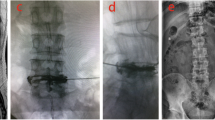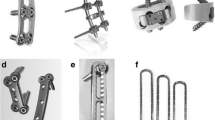Abstract
Purpose
To determine the efficacy of discography and discoblock in the treatment of low back pain (LBP) associated with painful Schmorl’s nodes (SNs).
Methods
Between January 2010 and February 2015, 46 patients were studied who had LBP suspected to be secondary to SNs. There were 34 men and 12 women, and mean age was 54.2 years (range 42–68 years). All patients underwent provocation discography, and discoblock was given to positive patients (confirmed to have painful SNs). Visual analogue scores (VAS) and the Oswestry Disability Index (ODI) were evaluated at 4 h and 1, 3, 6, and 12 months post-operatively. MRI was also used to evaluate the SNs at 12 months.
Results
Discography was performed on a total of 60 discs without infection or other complications. Positive findings were found in 71.7% discs; 20.0% were negative, and 8.3% were indeterminate. Among the positive patients who underwent discoblock, 89.2% reported an improvement in their LBP, and none reported worsening symptoms. VAS and ODI scores decreased significantly after discoblock, and there were no significant differences between 4 h and 1, 3, 6, and 12 months post-operatively. In patients with painful SNs, the vertebral body bone marrow surrounding the SN was characterized by low T1 and high T2 signals on MRI. At 12 months, the node demonstrated either high T1 and T2 signals or low T1 and T2 signals. The SNs tended to remain stable in size over time.
Conclusions
Painful SNs refractory to medical or physical therapy should be an indication for treatment with discography and discoblock.



Similar content being viewed by others
References
Schmorl G (1927) Uber die an den wirbelbandscheiben vorkommenden ausdehnungs—und zerreisungsvorgange und die dadurch an ihnen und der wirbelspongiosa hervorgerufenen veranderungen. Verh Dtsch Path Ges 22:250
Resnick D, Niwayama G (1978) Intravertebral disk herniation cartilaginous (Schmorl’s) nodes. Radiology 126:57–65
Hamanishi C, Kawabata T, Yosii T, Tanaka S (1994) Schmorl’s nodes on magnetic resonance imaging. Their incidence and clinical relevance. Spine 19:450–453
Jensen MC, Brant-Zawadski MN, Obuchowski N, Modic MT, Malkasian D, Ross JS (1994) Magnetic resonance imaging of the lumbar spine in people without back pain. N Engl J Med 331:69–73
Coventry MB, Ghormley RK, Kernohan JW (1945) The intervertebral disc: its microscopic anatomy and pathology. Part I. Anatomy, development, and physiology. J Bone Jnt Surg Am 27:105–112
Hilton RC, Ball J, Benn RT (1976) Vertebral end-plate lesions (Schmorl’s nodes) in the dorsolumbar spine. Ann Rheum Dis 35:127–132
Keyes DC, Compere EL (1932) The normal and pathological physiology of the nucleus pulposus of the intervertebral disc: an anatomical, clinical, and experimental study. J Bone Jnt Surg Am 14:897–938
Fahey V, Opeskin K, Silberstein M, Anderson R, Briggs C (1998) The pathogenesis of Schmorl’s nodes in relation to acute trauma. An autopsy study. Spine (Phila Pa 1976) 23:2272–2275
Takahashi K, Takata K (1994) Large painful Schmorl’s node: a case report. J Spinal Disord 7(1):77–81
Hasegawa K, Ogose A, Morita T et al (2004) Painful Schmorl’s node treated by lumbar interbody fusion. Spinal Cord 42(2):124–128
Grivé E, Rovira A, Capellades J, Rivas A, Pedraza S (1999) Radiographic findings in two cases of acute Schmorl’s nodes. Am J Neuroradiol 20:1717–1721
Takahashi K, Miyakazi T, Ohnari H, Takino T, Tomita K (1995) Schmorl’s nodes and low back pain. Analysis of MRI findingsin symptomatic and asymptomatic individuals. Eur Spine J 4:56–59
Masala S, Pipitone V, Tomassini M, Massari F, Romagnoli A, Simonetti G (2006) Percutaneous vertebroplasty in painful schmorl nodes. Cardiovasc Intervent Radiol 29(1):97–101
Peng B, Chen J, Kuang Z, Li D, Pang X, Zhang X (2009) Diagnosis and surgical treatment of back pain originating from endplate. Eur Spine J 18:1035–1040
Jang JS, Kwon HK, Lee JJ, Hwang SM, Lim SY (2010) Rami communicans nerve block for the treatment of symptomatic Schmorl’s nodes—a case report. Korean J Pain 23(4):262–265
Ohtori S, Kinoshita T, Yamashita M et al (2009) Results of surgery for discogenic low back pain: a randomized study using discography versus discoblock for diagnosis. Spine (Phila Pa 1976) 34(13):1345–1348
Bogduk N (1988) Acute back pain: what is the lesion? In: Proceedings of a symposium on Acute Back Pain, 2nd European Congress on back pain, Montreux, pp 6–16
Luoma K, Vehmas T, Kerttula L, Grönblad M, Rinne E (2016) Chronic low back pain in relation to Modic changes, bony endplate lesions, and disc degeneration in a prospective MRI study. Eur Spine J 25(9):2873–2881
Teraguchi M, Yoshimura N, Hashizume H, Muraki S, Yamada H, Oka H, Minamide A, Nakagawa H, Ishimoto Y, Nagata K, Kagotani R, Tanaka S, Kawaguchi H, Nakamura K, Akune T, Yoshida M (2015) The association of combination of disc degeneration, end plate signal change, and Schmorl node with low back pain in a large population study: the Wakayama Spine Study. Spine J 15(4):622–628
Park P, Tran NK, Gala VC, Hoff JT, Quint DJ (2007) The radiographic evolution of a Schmorl’s node. Br J Neurosurg 21(2):224–227
Simmons JW, Emery SF, McMillin JN, Landa D, Kimmich SJ (1991) Awake discography. A comparison study with magnetic resonance imaging. Spine 16:S216–S221
Chen JY, Ding Y, Lu RY et al (2011) Correlation between MR imaging and discography with provocative concordant pain in patients with low back pain. Clin J Pain 27:125–130
Derby R, Kim BJ, Lee SH, Chen Y, Seo KS, Aprill C (2005) Comparison of discographic findings in asymptomatic subject discs and the negative discs of chronic LBP patients: can discography distinguish asymptomatic discs among morphologically abnormal discs? Spine J 5:389–394
Lim CH, Jee WH, Son BC, Kim DH, Ha KY, Park CK (2005) Discogenic lumbar pain: association with MR imaging and CT discography. Eur J Radiol 54:431–437
Bobechko WP, Hirsch C (1965) Auto-immune response to nucleus pulposus in the rabbit. J Bone Joint Surg Br 47:574–580
Takatalo J, Karppinen J, Niinimaki J et al (2012) Association of Modic changes, Schmorl’s nodes, spondylolytic defects, high-intensity zone lesions, disc herniations, and radial tears with low back symptom severity among young Finnish adults. Spine (Phila Pa 1976) 37:1231–1239
Author information
Authors and Affiliations
Corresponding author
Ethics declarations
Funding
National Natural Science Foundation of China (Project No. 31270997) and Zhejiang Medical and Health Science and Technology project (Project No. 2016136915).
Conflict of interest
Each author certifies that he or she has no commercial associations (e.g., consultancies, stock ownership, equity interest, patent/licensing arrangements, etc.) that might pose a conflict of interest in connection with the submitted article.
Additional information
J. Liu and L. Hao contributed equally to this paper and should be considered co-first authors.
Rights and permissions
About this article
Cite this article
Liu, J., Hao, L., Zhang, X. et al. Painful Schmorl’s nodes treated by discography and discoblock. Eur Spine J 27, 13–18 (2018). https://doi.org/10.1007/s00586-017-4996-8
Received:
Revised:
Accepted:
Published:
Issue Date:
DOI: https://doi.org/10.1007/s00586-017-4996-8




